Actual Innovation: MasterPiece Arms Bolt-Action Competition Chassis
At RECOIL, we review every product fairly and without bias. Making a purchase through one of our links may earn us a small commission, and helps support independent gun reviews. Read our affiliate policy.
Find out more about how we test products.
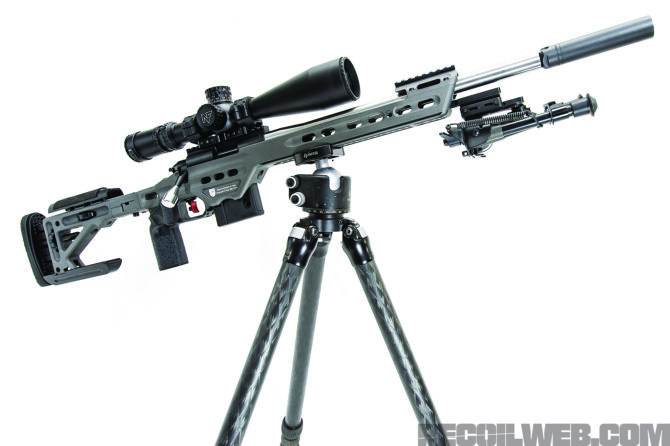
This article originally appeared in RECOIL Issue 40
MasterPiece Arms Bolt-Action Competition Chassis Does What Others Can't
The word innovation gets thrown around a lot, but MasterPiece Arms is one of the few companies putting innovation into action on a continuous basis. MPA has modernized its bolt-action chassis with a little luck and a lot of listening.
When Phil Cashin bought MPA in 2008, he had a different vision than the path the company had been trotting along. Cashin took a hard right turn into the precision rifle market, which was a surprise to those of us who knew the company for their semi-auto trailer trash Uzi clones. MPA chassis are now the most-used chassis by precision long-range competitors, according to a Precision Rifle Series survey. And, most of the improvements to MPA chassis have come as suggestions from competitors.
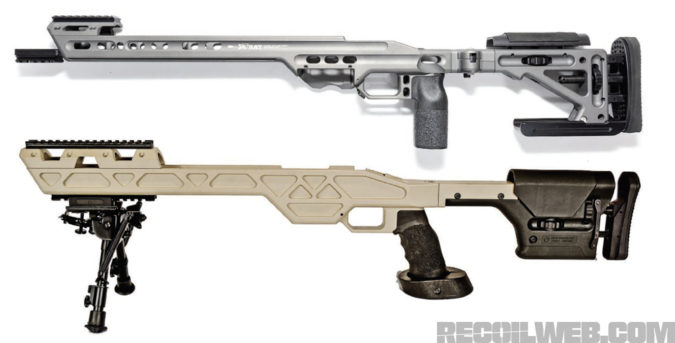
If you’re familiar with shooting a traditional stock, the MPA chassis might seem like a product from the space age. But we’ve officially been in the space age since 1957, so just go with the flow and be open to trying out a new system. Machining a chassis instead of dealing with expensive and time-consuming molds in the manufacturing process provides nearly limitless opportunities for iterative improvement. In the case of the MPA BA Competition Chassis, it rocks more capabilities than any other stock or chassis currently on the market.
Lucky by Design
MPA’s first chassis was designed in 2014, and it was an eyesore. Hints of the original chassis can be seen in the new MPA BA Competition Chassis. The skeletonized design of the new chassis is purpose-built; every aspect of the chassis makes shooting either easier, faster, or more accurate.
Cashin said he got lucky with the first chassis design because it’s allowed for backward compatibility. “The base system of our chassis hasn’t really changed over the past four years. We’re operating from the standpoint that we want our technology to be backward compatible,” says Cashin. “So a customer who bought a chassis from us four years ago doesn’t have to feel obligated to spend $1,000 on a new chassis.”

In part because old MPA chassis don’t need to die when a new feature is unveiled, Cashin garnered a loyal customer base. If a customer bought an older MPA chassis, he can send it back to MPA for upgrades at a minimal cost — all it takes is a machine time and the old chassis is the hot new, new.
Key Features
MPA chassis are machined from a single piece of 6061 aluminum. The only part of the chassis that’s removable is the buttstock, which can be swapped from fixed to folding. Shooters with a need for a folding stock can order it instead of having the fixed stock. The downside of a folder is that its moving parts create a small opportunity for failure. If you don’t need a folder, stick with fixed. We like the idea of easier travel and not having to remove our can, so we opted for a folder to save space in the gun case.
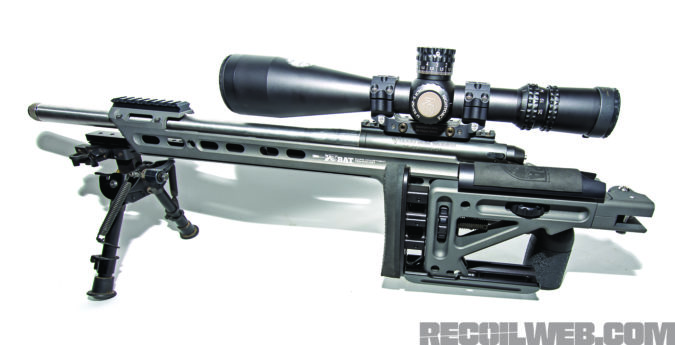
Folders are functional, if you actually use them.
There are several aspects of the MPA BA Competition Chassis that set it apart, so much so that other companies have now began to copy MPA’s homework. The most notable and most copied feature is the machined Arca-Swiss cut directly into the chassis. After MPA started cutting a dovetail into the chassis, several other companies have done the same, or offered an aftermarket Arca-Swiss plate that can be attached to the rifle. An Arca-Swiss style dovetail allows the rifle to be attached directly to a tripod. In many cases, shooting off of a tripod is as stable as shooting prone.
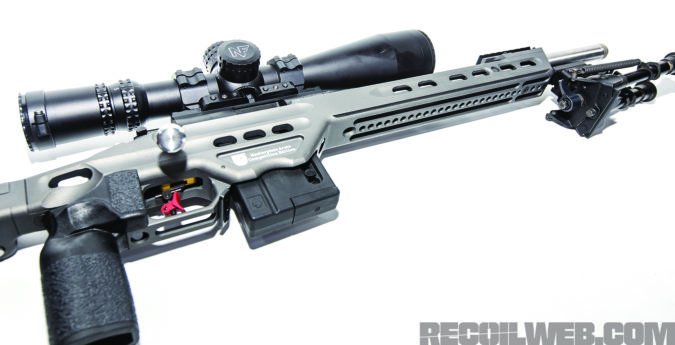
Discreet machining along the forend is a huge part of MPA’s success in the precision rifle arena.
The dovetail cut mates up with MPA’s Rapid Adjustment Technology (RAT) line of accessories. MPA RAT adapters allow for the shooter to quickly move a bipod along the length of the rail. This is beneficial for awkward shooting positions, like shooting from the top of a 55-gallon drum. By moving the bipod back, you can build a more stable position with both the bipod and rear bag in contact with the drum. Because the RAT system is so easy to adjust, moving the adapters can be completed while on the clock.
MPA’s spigot mount comes in two forms, Picatinny or dovetail. By extending the real estate of the forend, the spigot mount gives you another spot to mount a bipod. Mounting the bipod to the spigot leaves the rest of the forend for use with the RAT system or tripod.
Along the bottom of the rail are multiple holes, and while it may seem like aesthetics or possibly weight-reduction, there’s a purpose. One of the most-used MPA accessories is the barricade stop. With a push of a button, you can move the barricade stop along the length of the forend by putting it into any hole. Having so many options for the barricade stop lends to much more stability and less wobble when shooting from barricades of any width.
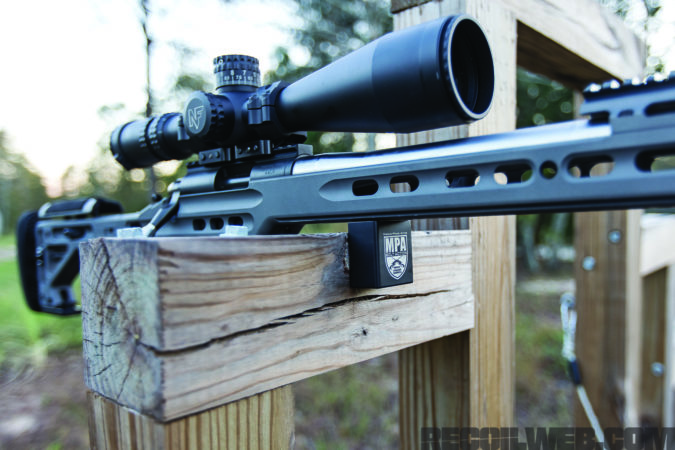
Having a barricade stop improves stability.
Originally, MPA chassis shipped with an angled AR-style pistol grip. Most shooters would place their thumb on the thumb rest that’s machined into the chassis. Cashin realized that using an angled AR grip caused undue tension in the shooter’s wrist. After over 30 versions, the Enhanced Vertical Grip (EVG) was born. The EVG is comfortable to use because it has specific areas to support your thumb and trigger finger. Having a steady but not stressed grip helps mitigate the shaking that occurs from hand tension. The EVG is the most comfortable detachable grip we’ve used for long-range shooting.
Adding weight to a rifle helps manage recoil. Some shooters hollow out traditional stocks and add weight at specific points to better balance the rifle and lessen recoil. When Cashin saw a shooter at a match adding weight with shotgun pellets in his stock, Cashin had an epiphany. A low-profile weight system was designed for the MPA systems. The Weight Tuning Kit can add a total of 4.4 pounds or as little as one pound. Weights attach to the forend or buttstock. Adding the weights is as simple as removing whatever is in the way and putting the rifle back together; it’s as easy as Legos. Once installed, the weights look like they were part of the rifle the whole time.
Measuring muzzle velocity using a chronograph is a necessity for precision shooters. We use it to predict the wear on the barrel, and also as one of the many variables for ballistic engines. Knowing the muzzle velocity helps you gather the gun data instead of having to document data on previous engagement. Many competitors travel with a MagnetoSpeed chronograph and recheck the muzzle velocity at matches. The problem is that the MagnetoSpeed is normally hung directly from the barrel, which shifts the point of impact. So those rounds cannot be used to confirm zero or data. MPA built a solution, the RAT MagnetoSpeed Adaptor. By attaching the MagnetoSpeed to the dovetail version of the spigot mount, it doesn’t come in contact with the barrel.
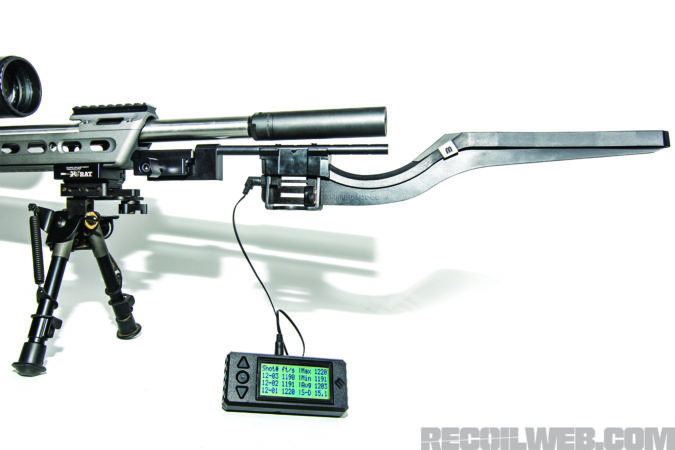
No more barrel shift when chronographing, thanks to the MPA RAT MagnetoSpeed adapter. (Archived chrono data shown.)
Rarely do competitors have to do a magazine change in the middle of a stage. But if it has to be done, it better be as efficient as possible so you’re not fumbling around with a magazine. Cashin worked with pro shooter Ryan Castle to develop what’s known as the Ryan Castle Mag Cut. The left side of the magazine well is cut, making popping a new mag in faster than the standard cut where you have to perfectly align the mag and ease it in.
With the release of the Competition Chassis, MPA nixed the rear monopod that’s found on other MPA chassis. Instead, a Bag Rider or an Enhanced Bag Rider comes installed on the chassis. The Bag Rider extends the bottom length of the buttstock and the enhanced version is even longer. This feature goes hand-in-hand with a rear bag. Shooters can move the rear bag forward or rearward to adjust the elevation of the muzzle. A rear bag used in this manner allows for large and small adjustments, so you can get stable on your target and have minimal wobble.
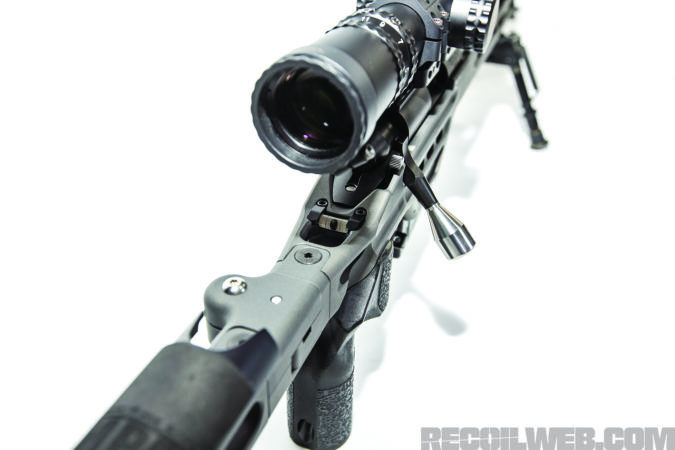
The bubble level is in an ideal location for a quick peek to make sure the rifle isn’t canted.
The last key feature of the MPA BA Competition Chassis is the inclinometer leveling system. In layman’s terms, it’s a bubble level. Even a small amount of cant can put your impacts off target. Many long-range shooters install aftermarket bubble levels on their rifles. With the integration of a level in the MPA chassis, you can see if the rifle is level without taking your face off the cheek-piece.
But Wait, There’s More
Chassis fans choose chassis for their adaptability and modularity. Non-chassis shooters end up seeing the light once they get some time behind a well-designed chassis. Many chassis have similar features, and that’s what we like about these systems. We like that you can adjust the length of pull and cheek-piece and make adjustments on the fly.
Even though it’s not necessary, you can glass bed the action and barrel thanks to the V-Bedding system. A Picatinny bridge at the front of the chassis gives a base for mounting night vision or other electro-optics. There are six QD swivel locations, four on the buttstock and two toward the front of the forend. The adjustable buttstock provides a length of pull between 13.75 to 14.75 inches and the pad on the buttstock can be tilted and moved to ensure the best fit for you. With a turn of a wheel, the cheek-piece moves up and down. Having an adjustable cheek-piece is often overlooked by shooters, but it’s the secret to getting consistent eye relief each and every time you put your head on the rifle.
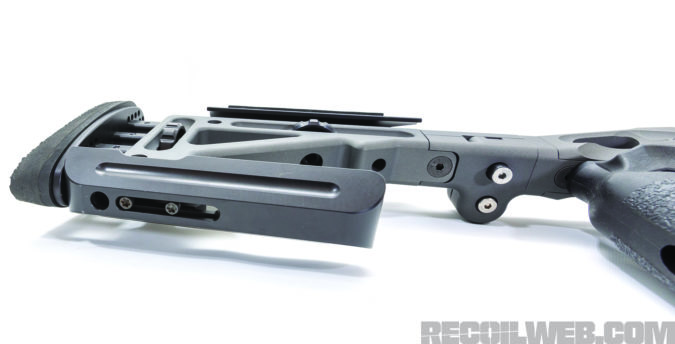
An extended bag rider is the perfect mate for a rear bag.
The MPA BA Competition Chassis accepts a gamut of popular actions and it’s even available with left-handed options. All MPA chassis are finished in Cerakote; the standard colors available are black, burnt bronze, flat dark earth, gunmetal, marine red, NRA blue, sniper green, and tungsten. Custom finishes are available; you just have to contact MPA.
With all this good, there’s got to be a little bit of bad. Fortunately, the bad isn’t a deal breaker. The screw sizes aren’t the same on the chassis. This makes sense since some parts need larger screws for their strength.
To remove and replace accessories, you better have a mini
toolbox. We had a set of Fix It Sticks, which had all the bits we needed. For example, the spigot mount needed a 1/8 bit, while the Bag Rider needed a T-25, the Night Vision Bridge needed a T-15, and the Weight Tuning — we think you get the idea. But once you have your rifle put together the way you want, having all the bits and playing gun Barbies, swapping out pieces doesn’t have to happen unless you want it to.
Shootability
To test this chassis, we wanted to burn through a lot of ammo and have fun while doing so. We opted to put a Vudoo Gun Works V-22 barreled action in the MPA BA Competition Chassis. The V-22 came with a Timney Triggers Calvin Elite Custom Remington Model 700 trigger. We topped the rifle off with a Nightforce 5-25 ATACR with the new Mil-XT reticle. You can read more about the V-22 and the Mil-XT in separate articles in this issue. And, as always, we run suppressed when possible, so we put an Acadian Armament Lynx silencer on this build.
We wanted to shoot this gun until we ran out of ammo. The V-22 is chambered specifically for Lapua 22LR, so we only shot about 500 rounds to prevent breaking the bank. Lapua ammo is known for shooting well, but it’s more expensive than the average 22LR you’ll find at Walmart.
We could sum up the shootabilty of the MPA BA Competition Chassis with one word: easy. It was quick to adjust the fit between different shooters despite varying in size. The options seem to be endless, and we expect that by the time this article goes to print, MPA will have a handful of new accessories or upgrades for this chassis.
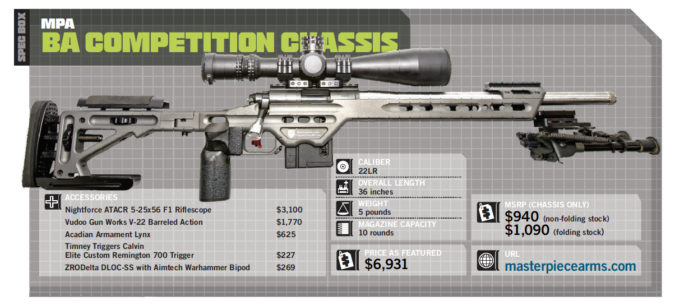
Visit https://masterpiecearms.com/
Why you can trust RECOIL
Since our founding in 2012, RECOIL remains the premier firearms lifestyle publication for the modern shooting enthusiast. We deliver cutting-edge coverage of guns, gear, accessories and technology. We go beyond basic reviews, providing no B.S. buyer’s guides, hands-on testing and expert analysis on everything from firearms and survival equipment to watches and vehicles.
Our reviewers are the backbone of our operation and come from diverse shooting backgrounds: Former law enforcement, military veterans, competitive shooters, seasoned hunters and plain old firearms enthusiasts. Furthermore, we’re not just gun experts, but dedicated journalists who adhere to the strictest standards of our profession.
At RECOIL, editorial independence is the foundation of everything we publish and the cornerstone of reader trust. Our editors, writers and content creators make all editorial decisions independently, free from outside influence. That boils down to: advertisers don’t dictate our coverage, the outcomes of our reviews or what we recommend in our buyer’s guides. First and always, our commitment is to our audience—ensuring every review and article is accurate, unbiased, and driven by real-world experience.
Whether you’re selecting your next firearm, upgrading your gear, or exploring the latest innovations in the shooting world, RECOIL provides the trusted insights you need to make informed decisions. Learn more about our Editorial Standards and how we review products.

NEXT STEP: Download Your Free Target Pack from RECOIL
For years, RECOIL magazine has treated its readers to a full-size (sometimes full color!) shooting target tucked into each big issue. Now we've compiled over 50 of our most popular targets into this one digital PDF download. From handgun drills to AR-15 practice, these 50+ targets have you covered. Print off as many as you like (ammo not included).Get your pack of 50 Print-at-Home targets when you subscribe to the RECOIL email newsletter. We'll send you weekly updates on guns, gear, industry news, and special offers from leading manufacturers - your guide to the firearms lifestyle.
You want this. Trust Us.

